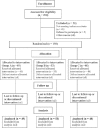Adductor canal block for post-operative analgesia after simultaneous bilateral total knee replacement: A randomised controlled trial to study the effect of addition of dexmedetomidine to ropivacaine
- PMID: 29217856
- PMCID: PMC5703004
- DOI: 10.4103/ija.IJA_277_17
Adductor canal block for post-operative analgesia after simultaneous bilateral total knee replacement: A randomised controlled trial to study the effect of addition of dexmedetomidine to ropivacaine
Abstract
Background and aims: Knee replacement surgery causes tremendous post-operative pain and adductor canal block (ACB) is used for post-operative analgesia. This is a randomised, controlled, three-arm parallel group study using different doses of dexmedetomidine added to ropiavcaine for ACB.
Methods: A total of 150 patients aged 18-75 years, scheduled for simultaneous bilateral total knee replacement, received ultrasound-guided ACB. They were randomised into three groups -Group A received ACB with plain ropivacaine; Groups B and C received ACB with ropivacaine and addition of dexmedetomidine 0.25 μg/kg and 0.50 μg/kg, respectively, on each side of ACB. The primary outcome was the duration of analgesia. Total opioid consumption, success of early ambulation, and level of patient satisfaction were also assessed.
Results: The patient characteristics and block success rates were comparable in all groups. Group C patients had longer duration of analgesia (Group C 18.4 h ± 7.4; Group B 14.6 ± 7.1; Group A 10.8 ± 7; P < 0.001); lesser tramadol consumption (Group C 43.8 mg ± 53.2; Group B 76.4 ± 49.6; Group A 93.9 mg ± 58.3; P < 0.001) and lesser pain on movement (P < 0.001). The patients in Group B and C walked more steps than in Group A (P < 0.002). The level of patient satisfaction was highest in Group C (P < 0.001).
Conclusions: The addition of dexmedetomidine to ropivacaine resulted in longer duration of analgesia after adductor canal block for simultaneous bilateral total knee replacement surgery.
Keywords: Arthroplasty; dexmedetomidine; diagnostic imaging; knee; nerve block; replacement; ropivacaine.
Conflict of interest statement
There are no conflicts of interest.
Figures




References
-
- Jaeger P, Nielsen ZJ, Henningsen MH, Hilsted KL, Mathiesen O, Dahl JB, et al. Adductor canal block versus femoral nerve block and quadriceps strength: A randomized, double-blind, placebo-controlled, crossover study in healthy volunteers. Anesthesiology. 2013;118:409–15. - PubMed
-
- Abdallah FW, Whelan DB, Chan VW, Prasad GA, Endersby RV, Theodoropolous J, et al. Adductor canal block provides noninferior analgesia and superior quadriceps strength compared with femoral nerve block in anterior cruciate ligament reconstruction. Anesthesiology. 2016;124:1053–64. - PubMed
-
- Compston A. Aids to the investigation of peripheral nerve injuries. Medical Research Council: Nerve Injuries Research Committee. His Majesty's Stationery Office: 1942; pp 48 (iii) and 74 figures and 7 diagrams; with aids to the examination of the peripheral nervous system. By Michael O'Brien for the Guarantors of Brain. Saunders Elsevier. 2010:[8] 64–94. Brain 2010;133:2838-44. - PubMed
-
- Fu D, Li G, Chen K, Zeng H, Zhang X, Cai Z, et al. Comparison of clinical outcome between simultaneous-bilateral and staged-bilateral total knee arthroplasty: A systematic review of retrospective studies. J Arthroplasty. 2013;28:1141–7. - PubMed
LinkOut - more resources
Full Text Sources
Other Literature Sources
Medical

